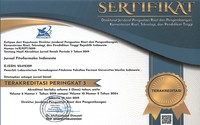In Silico Screening Inhibitors Histamine H2 Chemical Compounds in Licorice Plants (Glycyrrhiza glabra L.) Using Autodock Vina
Abstract
Keywords
Full Text:
PDFReferences
Bell, R. F. et al. (2021) ‘Liquorice for pain?’, Therapeutic advances in psychopharmacology. SAGE Publications Sage UK: London, England, 11.
Donyapour, N. (2022) Predicting the Properties of Ligands Using Molecular Dynamics and Machine Learning. Michigan State University.
Engevik, A. C., Kaji, I. and Goldenring, J. R. (2020) ‘The physiology of the gastric parietal cell’, Physiological reviews. American Physiological Society Bethesda, MD, 100(2), pp. 573–602.
Jabeen, F. et al. (2020) ‘Computational modeling for bionanocomposites’, Bionanocomposites. Elsevier, pp. 367–420.
Jain, R. et al. (2022) ‘Oncopreventive and oncotherapeutic potential of licorice triterpenoid compound glycyrrhizin and its derivatives: Molecular insights’, Pharmacological Research. Elsevier, 178, p. 106138.
Jakhar, R. et al. (2020) ‘Relevance of molecular docking studies in drug designing’, Current Bioinformatics. Bentham Science Publishers, 15(4), pp. 270–278.
de Lócio, L. L. et al. (2022) ‘Application of Heterocycles as an Alternative for the Discovery of New Anti-ulcer Compounds: A Mini-Review’, Current Pharmaceutical Design. Bentham Science Publishers, 28(17), pp. 1373–1388.
Najib, A. et al. (2019) ‘Insilico screening chemical compounds α-glucosidase inhibitor from cordia myxa L.’, International Journal of Research in Pharmaceutical Sciences, 10(3). doi: 10.26452/ijrps.v10i3.1419.
Roy, A. J. et al. (2023) ‘A review on herbal drugs used in the treatment of peptic ulcer’, Current Drug Discovery Technologies. Bentham Science Publishers, 20(3), pp. 4–15.
Tahir, M., Baharuddin, M. and Najib, A. (2023) ‘In silico screening of brotowali (Tinospora crispa L.) chemical compounds as $α$-glucosidase inhibitor using the pyrx program’, in AIP Conference Proceedings.
Umashankar, V. et al. (2021) ‘Phytochemical moieties from Indian traditional medicine for targeting dual hotspots on SARS-CoV-2 spike protein: an integrative in-silico approach’, Frontiers in Medicine. Frontiers Media SA, 8, p. 672629.
Wahab, S. et al. (2021) ‘Glycyrrhiza glabra (Licorice): A comprehensive review on its phytochemistry, biological activities, clinical evidence and toxicology’, Plants. MDPI, 10(12), p. 2751.
Wang, H. et al. (2023) ‘Scientific discovery in the age of artificial intelligence’, Nature. Nature Publishing Group UK London, 620(7972), pp. 47–60.
DOI: https://doi.org/10.33096/jffi.v10i3.1100
Copyright (c) 2023 Ahmad Najib, Abd. Malik, Sumartono Sumartono

This work is licensed under a Creative Commons Attribution-ShareAlike 4.0 International License.
Indexed by:
ISSN: 2356-0398 | e-ISSN: 2541-2329
Editor's Address:
Third Floor Pharmacognosy-phytochemistry laboratory building, Urip Sumoharjo road km. 5 Campus II UMI, Makassar, South Sulawesi, Indonesia
Phone: +6281524045514
Fax: +62411425619
E-mail: editorjfi@umi.ac.id

















.jpg)

